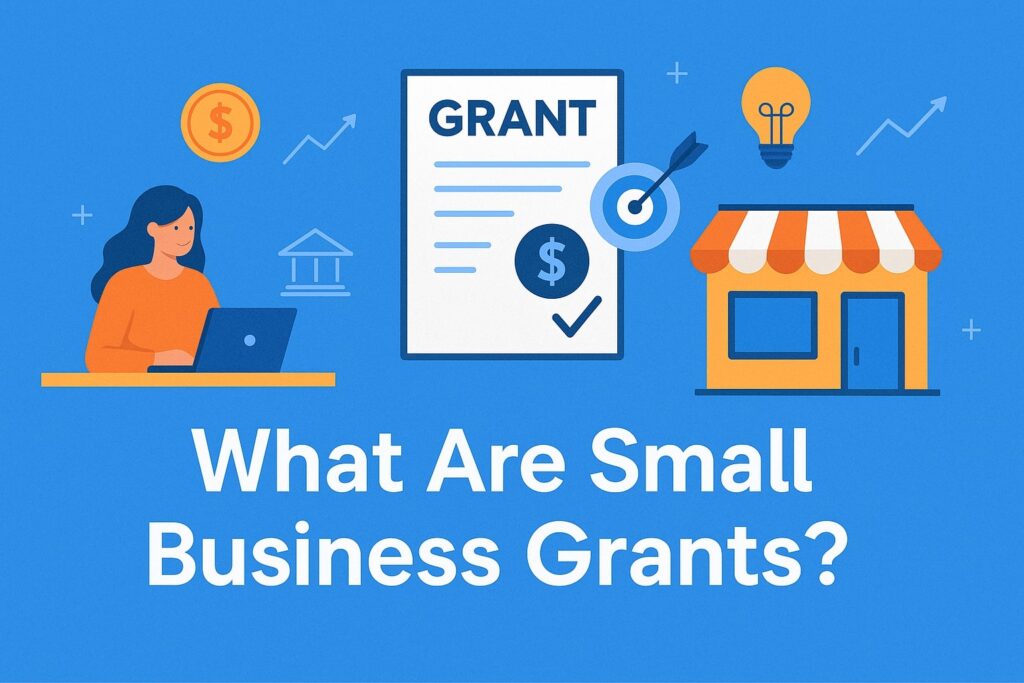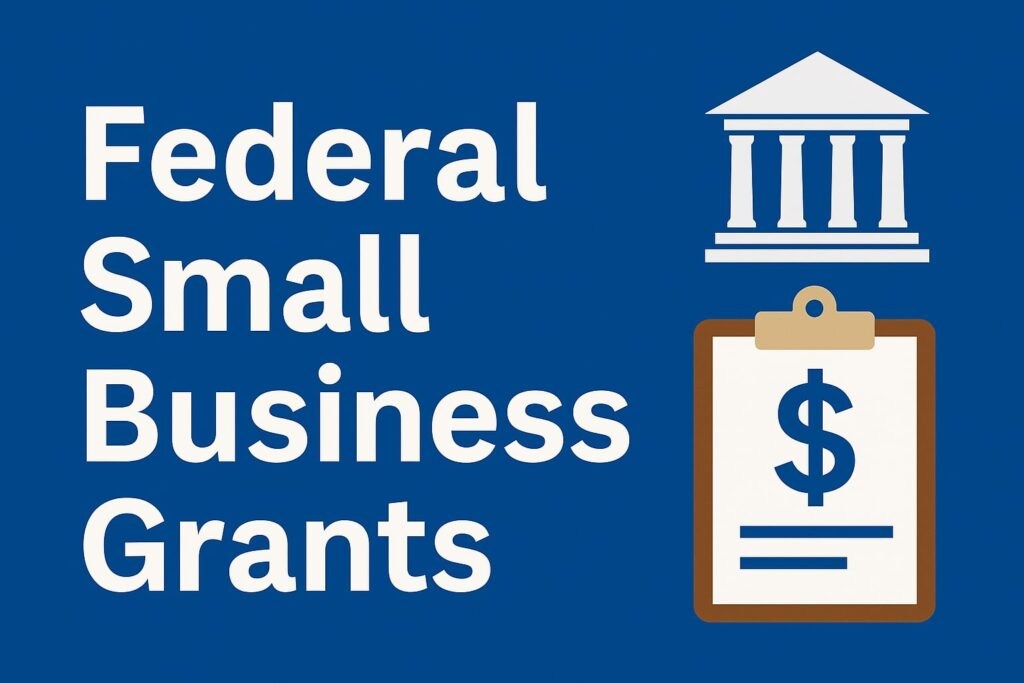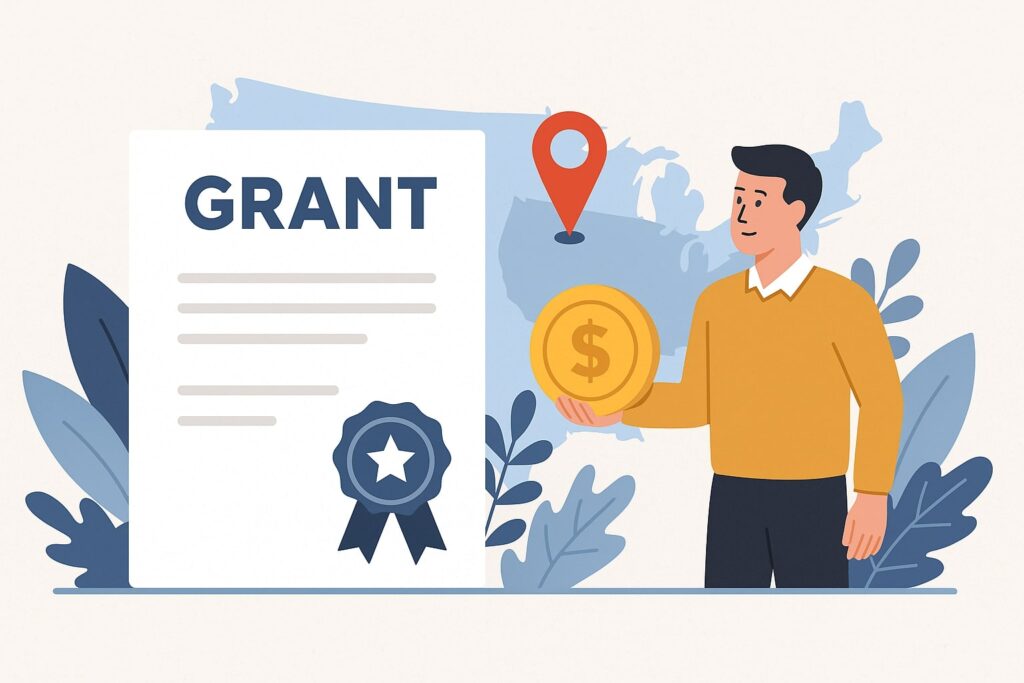
Ultimate Guide to Small Business Grants and Where to Find Them
Small business grants are non-repayable funds provided by governments, corporations, and nonprofits to help entrepreneurs start and grow their companies. Unlike loans, grants do not have to be repaid.
This makes them a highly attractive source of funding for small business startups and expansions. However, grants are typically highly competitive, purpose-driven awards.
Eligibility often depends on factors like industry, location, or owner demographics, and recipients must usually follow strict rules on how the money is spent.
In recent years, grant programs have expanded (for example, the $10 billion State Small Business Credit Initiative), but businesses must still qualify and apply for each opportunity.
This guide explains what small business grants are, highlights major U.S. grant programs (federal, state, and private), and shows where to find grant opportunities.
We include expert-sourced advice on applying and use up-to-date information from SBA, Chamber of Commerce, and other resources to ensure accuracy.
Whether you’re a new entrepreneur seeking grants available for small businesses or an existing business owner hunting for growth funding, this overview will help you navigate the options.
What Are Small Business Grants?

Small business grants are financial awards given to qualifying businesses (often without strings attached to repayment). Key characteristics include:
- Non-repayable funding: Unlike loans, small business grants do not have to be repaid (unless you violate grant terms). This makes them “free money” in principle, but it also means the awarding agency is highly selective.
- Purpose-driven: Grants are often targeted for specific goals. For example, federal research grants (SBIR/STTR) fund innovative R&D projects, while other grants may support manufacturing, exporting, technology development, or underserved communities.
Many grants require that funds be used for qualified expenses (equipment, training, research, etc.). - Competitive and conditional: The application process is rigorous. As one expert notes, “competition is fierce” for startup grants, and most programs require businesses to have at least a year of operation before qualifying.
You must submit detailed proposals and meet all eligibility rules. Grantees are usually required to report on how funds are used. - Varied sources: Grants come from government entities (federal, state, local), as well as private and nonprofit sponsors.
For instance, the U.S. Small Business Administration (SBA) does not give grants to new businesses directly, but it notes federal agencies like the National Institutes of Health or Department of Energy may provide R&D grants through programs like SBIR/STTR. Other agencies (e.g. USDA, EDA) offer grants through their own programs.
Example: The USDA’s Rural Business Development Grants program “provides grant money to assist with economic development planning and/or the financing or expansion of rural businesses”. Although these funds are often channeled through local entities, the purpose is to help small rural companies grow.
Key takeaways:
- Grants = free money for business projects (no repayment).
- They usually target specific purposes or groups (research, veterans, women, etc.).
- They are very competitive – more so than loans.
- Applicants must meet strict criteria and often report back on outcomes.
Federal Small Business Grants

The U.S. federal government offers a limited number of grant programs for small businesses, typically focused on research, innovation, or strategic goals.
To find federal grants, start at Grants.gov, the official portal listing thousands of current federal funding opportunities. Search by keyword or agency to find grants in industries like technology, health, or community development. Some key federal programs include:
- SBIR/STTR (Small Business Innovation Research/Technology Transfer): These grant programs reserve federal R&D dollars for small businesses. SBIR Phase I awards (roughly $50K–$275K) fund feasibility studies, and Phase II grants (often up to $1.8 million) fund further R&D and commercialization.
(To qualify, your U.S.-based firm must be for-profit with ≤500 employees.) SBIR is administered by several agencies (NSF, NIH, USDA, EPA, etc.), each posting solicitations on Grants.gov.
The SBA describes SBIR as a way to “encourage small businesses to explore their technological potential” by funding critical startup and development stages. Note that STTR is similar but requires partnering with a nonprofit research institution. - Economic Development Administration (EDA) Grants: The Department of Commerce’s EDA provides grants to support regional economic growth and resilience.
Award amounts vary; projects often involve infrastructure, disaster recovery, broadband, or innovation clusters. According to Homebase, EDA grants focus on “economic resilience, recovery from disasters, infrastructure development, and regional economic growth”.
Eligible applicants include state and local governments, nonprofits, and sometimes businesses (typically via state agencies). Use EDA’s website or Grants.gov to browse current EDA funding opportunities. - USDA Rural and Agricultural Grants: The USDA Rural Development agency offers grants aimed at rural small businesses.
For example, the Rural Business Development Grants (RBDG) help local governments and nonprofits fund projects that benefit rural businesses (such as incubators, training, or utilities).
As the USDA notes, this grant program is intended to “assist with economic development planning and/or the financing or expansion of rural businesses”.
(Though individuals or for-profit businesses usually cannot apply directly, eligible local entities pass funds to small businesses.) Check USDA Rural Development state offices for grant solicitations. - Other Federal Agencies: Many federal departments offer small-business-related grants.
For example, the National Institutes of Health and Department of Defense fund biotech and tech startups; the Department of Energy has clean energy grants; and Commerce’s Minority Business Development Agency (MBDA) sometimes provides grants to support minority-owned businesses.
Each agency publishes its current grant competitions on Grants.gov. As one source advises, “begin your search for a grant from the federal government at Grants.gov” for the most comprehensive list of opportunities.
Tip: Check Grants.gov often, and refine your search by “Small Business” or specific fields. Also look at agency-specific sites (e.g. sbir.gov) for details. Many federal grants require registration in the System for Award Management (SAM) and adherence to strict guidelines.
State and Local Small Business Grants

Beyond federal funding, state and local governments run numerous grant programs to spur economic development. These vary widely by state and often address local needs. Here’s what to know:
- State economic development grants: Each state’s commerce or economic development agency maintains its own list of funding programs.
For example, New Jersey’s Economic Development Authority offers a Small Business Improvement Grant that reimburses 50% of renovation or equipment costs (up to $50,000) for small companies.
Similarly, many states fund grants for technology innovation, export assistance, hiring incentives, or disaster recovery.
Check your state’s official economic development website or contact your Secretary of State or Governor’s Office of Economic Development. Some states publish searchable grant catalogs or even interactive maps of opportunities. - Local and regional programs: Counties, cities, and regional development organizations sometimes have grant funds or micro-grant contests.
For example, Minnesota’s Emerging Entrepreneur Loan Program uses federal funds to provide grants to nonprofit lenders; those nonprofits then make loans to minority-, low-income-, women-, veteran-, and disability-owned businesses.
Many municipalities also partner with Small Business Development Centers (SBDCs) or Chambers of Commerce to run grant competitions or offer technical assistance. Always check city or county business pages. - Intermediated funding: Keep in mind that some federal and state grants are distributed indirectly. As the U.S. Chamber notes, funds often “flow to state and local governments, and agencies, nonprofits, and institutions,” which then use them for local assistance.
This means your best resource might be state/local agencies or nonprofit economic development organizations. For example, some states require nonprofits or chambers to apply for federal grants and then use the money to support local entrepreneurs. - State-specific portals: Many states provide consolidated lists. For instance, New York State’s business development site offers a comprehensive list of grants and incubator programs by region.
Louisiana, California, and Texas (among others) likewise have online “access portals” for business grants and incentives. Finding the right site may require a web search (e.g. “California small business grants”) or contacting your state SBDC.
Example: State: “Small Business Improvement Grant” – New Jersey: provides a 50% reimbursement on eligible building improvements (max $50K) for businesses in designated areas.
State: “Emerging Entrepreneur Loan Program” – Minnesota: grants funds to nonprofits to expand lending to underserved entrepreneurs.
Private and Corporate Grants for Small Businesses

In addition to government funding, many corporations, foundations, and nonprofits sponsor small business grants or competitions. These programs often focus on entrepreneurship, community impact, or underserved demographics. Here are a few notable examples:
- FedEx Small Business Grant Contest: An annual national contest by FedEx that awards cash grants. One grand-prize winner receives $50,000, and nine finalists get $20,000 each.
Applicants must have an active FedEx account and at least six months in business. This contest is very competitive but open to various industries. (See FedEx newsroom for application updates.) - Venmo Small Business Grant: Venmo’s business grant program awards $10,000 to each of 20 selected small businesses annually. Winners also receive mentorship and marketing support.
Eligible businesses must have a Venmo business profile in good standing, <10 employees, and at least $500 sales on Venmo in recent months. (Applications open yearly.) - Amber Grant (WomensNet): Focused on women entrepreneurs, Amber Grants provide up to $10,000 per month (three $10K awards each month) and three annual $25,000 awards to U.S. or Canadian women-owned businesses.
Applying once is sufficient for all monthly awards. This program accepts startups and established firms, as long as the business is at least 50% owned by a woman. - Awesome Foundation: A grassroots network of chapters that awards $1,000 grants monthly to “awesome” projects, including small business ideas. Applicants propose projects through a local Awesome chapter; awards are given by community volunteers.
There’s no strict business requirement or time-in-business minimum, so even very new ventures or side projects can apply. (See awesomefoundation.org for details.) - ZenBusiness $5K Grant: ZenBusiness (a business formation service) awards $5,000 each month to a new business that creates positive community impact.
Eligible applicants must have formed their business in the last 3–6 months and used ZenBusiness’s services. Winners get the cash plus free access to business tools and coaching. - Tory Burch Foundation Fellows: Although technically a fellowship program, this provides $5,000 education grants and networking to 50 women entrepreneurs each year (plus additional support). It requires the business to be majority women-owned and generating revenue.
- Others: Countless smaller grants and contests exist. For example, the National Association for the Self-Employed (NASE) offers quarterly Growth Grants up to $4,000, and companies like Jobber, Harley-Davidson (The Shop), Chase, Intuit/QuickBooks, and many more regularly run small business grant promotions.
Industry associations, community foundations, and nonprofit groups (e.g. MBDA, local chambers) may also have periodic grants.
These private programs often have simpler applications (sometimes just an online form and a short essay). However, they tend to attract many applicants. As with government grants, tailor your application to the sponsor’s mission.
For instance, demonstrate community impact for a program like Venmo’s or FedEx’s contest, and highlight entrepreneurial potential for innovation grants.
How to Find Small Business Grants
Finding the right grant opportunities requires research and persistence. Where to look:
- Grants.gov (Federal database): Start here for federal and federally-funded grants. Its search tool allows filtering by topics, agency, and eligibility. Create a Grants.gov account to save searches and receive updates. Use keywords like “small business,” “entrepreneurship,” or specific industries.
Note that federal grants on Grants.gov are often awarded to organizations (nonprofits, state agencies, etc.), but a relevant program might indirectly benefit your business through these partners. - SBIR.gov and Agency Sites: If you have an R&D project, check SBIR/STTR (sbir.gov) and the individual agency portals (NIH, NSF, DOE, etc.) for solicitations.
- State and Local Government Portals: Many states have searchable grant directories. For example, the New York State Empire State Development website lists grants by category and region.
Your state’s commerce/EDA site may list small business programs. Similarly, some cities publish business grant opportunities or lists of vendors. A simple web search (“[Your State] small business grants 2025”) can uncover recent programs. - SBA Resource Partners: The SBA’s Small Business Development Centers (SBDCs), Women’s Business Centers, and Minority Business Centers often maintain information on grants and can advise applicants.
While SBA itself doesn’t give startup grants, its counselors can help find ones offered by others (and help with applications). - Business and Industry Associations: Trade groups and professional associations sometimes publish grant news. Check newsletters or websites of groups related to your field.
- Chamber of Commerce and Nonprofit Guides: The U.S. Chamber of Commerce and many local chambers publish lists of grants and financing programs (as we’ve used here).
For example, the Chamber’s small business blog regularly updates grant listings. Also consider subscription grant databases like GrantWatch or Grants.gov sponsor websites. - News and Social Media: Follow reputable small business news sites (NerdWallet, Forbes, Inc., etc.) and social media accounts that highlight new grant contests.
Some platforms (LinkedIn, Facebook groups) and local news outlets announce region-specific grant programs.
In all cases, verify deadlines and eligibility carefully. Grant announcements often appear only for a short application window, and missed deadlines mean waiting another year or missing funding altogether.
How to Apply for Small Business Grants
Winning a grant depends heavily on a strong application. Follow these steps and best practices:
- Find and Research Opportunities: Identify grants that closely match your business type and needs. Carefully review the grant guidelines and eligibility criteria. Note deadlines, required forms, and what expenses are allowed.
- Gather Documentation: Prepare a solid business plan, financial statements (or projections), and any specialized materials the grant requires (e.g. letters of support, resumes of founders, technical data).
Have your Employer Identification Number (EIN) and registrations (like SAM.gov for federal grants) ready. - Write a Clear Proposal: Most grants require a written narrative. Explain who you are, what problem or opportunity your business addresses, how you will use the funds, and what outcomes you expect.
Be concise and compelling. As one guide advises, draft a proposal that “adequately addresses your business needs and highlights its mission”. Emphasize innovation, community impact, job creation, or other goals relevant to the grant. - Follow Instructions Exactly: Adhere strictly to the application format. Include all required elements (usually a cover page, budget, narrative, and any certifications).
Grants.gov and other portals often have specific forms. Submit before the deadline; many programs do not accept late applications. - Highlight Impact and Metrics: Grantors want to see how their money will make a difference. Use data or examples to show potential outcomes (e.g. number of jobs created, revenue growth, communities served). If possible, quantify benefits.
- Review and Edit: Have someone else review your application for clarity and completeness. Make sure there are no typos or missing pages. A polished application looks professional.
- Plan for Reporting: Be prepared to track how grant funds are spent. Most grants require follow-up reports detailing outcomes.
The U.S. Chamber suggests “establishing systems to track budgets, timelines, and expected deliverables” once funded. Knowing this upfront will help you comply later. - Seek Assistance: Use local resources like SBDCs or SCORE mentors to review your application before submission. They often know what reviewers look for.
Some grantees suggest applying to multiple appropriate grants in parallel, since success rates can be low. Even if you don’t receive one grant, the process of refining your proposal can help with future funding efforts. Consistency and persistence are key.
FAQ
Q.1: What’s the difference between a small business grant and a loan?
Answer: The biggest difference is repayment. Grants do not have to be repaid (unless you break the grant terms), whereas loans must be paid back with interest.
Grants are typically awarded to achieve a specific mission (e.g. research or community development) and often require detailed proposals and reporting.
Loans are evaluated mainly on creditworthiness and collateral, and the lender’s goal is to get their money back plus interest. Because grants don’t generate profit for the giver, they come with more strings attached.
Q.2: Where can I find grants for small businesses in the U.S.?
Answer: A good starting point is the federal Grants.gov portal, which lists all current federal and federally-funded grant programs. Search by keywords (like “small business” or your industry).
Also check the SBA website and SBIR/STTR program sites for specific tech and research grants. For state and local programs, visit your state’s economic development website or business portal (e.g. New York’s grant directory) and your city/county business page.
Don’t forget private opportunities: business associations, foundations, and corporations often advertise grant contests (e.g. FedEx, Amber Grant). SBA resource partners (SBDCs, SCORE) can also guide you to local and industry-specific grants.
Q.3: Can I get a grant to start my new business?
Answer: It’s very difficult for brand-new startups to qualify for grants. Most grants require an existing operation or proven concept. As one expert notes, “very few grant programs…accept businesses that haven’t been started yet,” and those that do are usually niche or highly specialized.
Instead, new entrepreneurs often pursue pitch competitions, accelerator programs, or small business loans to get initial funding.
(For example, some cities offer pitch grants of $25K–$50K to entrepreneurs without businesses yet.) Once you’ve started and have a bit of a track record, more grant options become available.
Q.4: What steps should I take to apply for a small business grant?
Answer: First, identify grants that match your business and review all eligibility rules. Then prepare required materials: a clear business plan, financial data, and a concise proposal explaining your project’s goals.
Follow the grant’s instructions exactly, and submit by the deadline. Emphasize how the funds will be used and the expected impact. After submission, be ready to provide any additional documentation.
If awarded, you’ll need to comply with reporting requirements on your expenditures and results. Thorough preparation and attention to detail are crucial in the application process.
Q.5: Are there grants specifically for women, minorities, or veterans?
Answer: Yes. Many programs target specific owner demographics. For example, the Amber Grant is for women entrepreneurs, the SBA offers some initiatives for veteran- and minority-owned businesses, and several corporate grants focus on diversity.
Also, agencies like the U.S. Department of Commerce’s Minority Business Development Agency (MBDA) provide support (though MBDA itself doesn’t directly give business grants, its centers can connect you to funding).
Research organizations that serve your community; they may have dedicated grant or loan programs.
Q.6: Is there an easy way to search and track grant opportunities?
Answer: Yes – beyond regular searches, use tools like email alerts from Grants.gov or funding newsletters. The SBA’s website and partner organizations often announce new grants. Some services (GrantWatch, FedDev, and state portals) compile lists of small business grants.
Also, joining small business networks or mailing lists (for example, local chamber of commerce newsletters) can alert you to competitions. Keeping a calendar of application deadlines and reminders will help ensure you don’t miss opportunities.
Q.7: What else can I do if I don’t qualify for a grant?
Answer: Grants are just one form of non-dilutive funding. If a grant isn’t available or you’re not eligible, consider other funding sources: small business loans (SBA microloans or traditional bank loans), investors, crowdfunding, or bootstrapping.
Loans require repayment, and investors require equity, but they can be easier to access than grants. You can also look into tax credits (e.g. R&D tax credits) that provide indirect funding. Combining different sources of funding is common for small businesses.
Conclusion
Small business grants offer valuable, free funding for entrepreneurs, but they require time and effort to obtain. In the United States, grants come from many sources – federal agencies, state and local programs, corporations, and nonprofits.
Key resources include Grants.gov for federal opportunities and each state’s economic development office for local programs. Private contests and foundation grants (like FedEx, Amber, or Awesome Foundation) also provide targeted awards.
Before applying, understand that grants are competitive and purpose-specific. You’ll need to match your business to the grant’s goals, prepare a strong business plan, and clearly explain how the money will be used.
Use help from SBA resource centers or business mentors if needed. When you do win a grant, it can be a game-changer – providing growth capital without added debt.
Stay informed by subscribing to business newsletters or following small business news sources. Check official sites regularly (Grants.gov, SBA, local agencies) and network with other business owners.
With diligent research and preparation, you can tap into grants to support your small business’s growth and innovation.